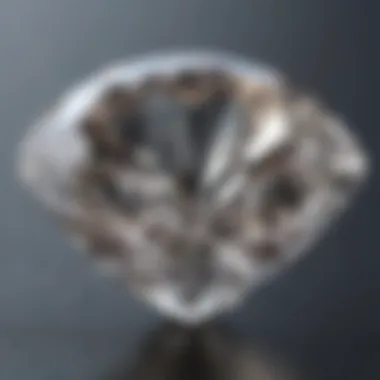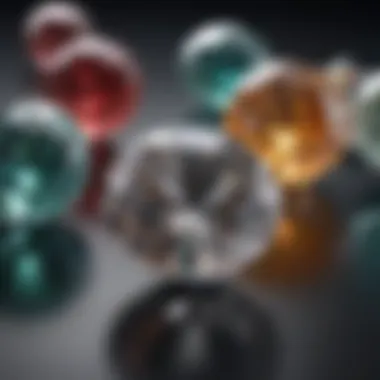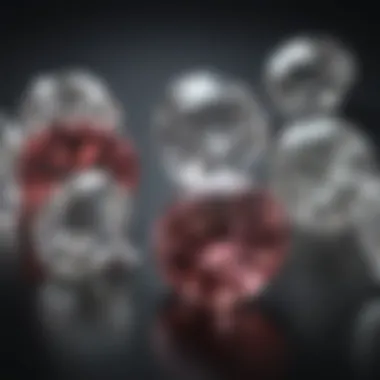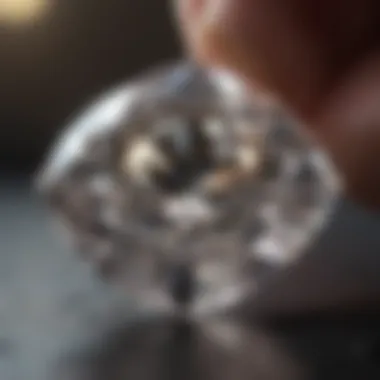Understanding the Cost of a 1.5 Carat Diamond


Intro
Gemstone Overview
Definition and Characteristics
A diamond is classified as a precious gemstone, renowned for its brilliant luster and hardness. Diamonds are composed of carbon atoms arranged in a crystal structure, making them one of the hardest known materials on Earth. They are evaluated based on the "Four Cs": cut, color, clarity, and carat weight. Each aspect contributes significantly to the diamond's overall appearance and value.
- Cut refers to how well the diamond has been shaped and faceted. A precise cut enhances the stone's sparkle.
- Color ranges from colorless to shades of yellow or brown. The less color, the higher the quality.
- Clarity addresses the presence of internal or external imperfections, known as inclusions and blemishes.
- Carat weight measures the diamond's size.
These factors together influence the desirability and price of a diamond, including a 1.5 carat stone.
Classification of Gemstones
Gemstones are broadly classified into two categories: precious and semi-precious. Diamonds fall under the precious stones class alongside rubies, sapphires, and emeralds. Within these categories, gemstones can also be classified based on origin, such as natural or synthetic.
- Natural Diamonds: Formed through geological processes over millions of years.
- Synthetic Diamonds: Created in labs under controlled conditions, they share similar physical properties with natural diamonds but typically cost less.
It's important to understand these classifications as they impact both availability and pricing.
Key Point: The classification of gemstones helps buyers navigate choices in terms of quality, origin, and cost.
Historical Significance
Ancient Uses and Cultural Importance
Throughout history, diamonds have held significant cultural and economic value. Ancient civilizations believed diamonds possessed mystical properties, often using them in religious and royal contexts. For instance, in India, diamonds were worn by nobles as symbols of status and power. In contrast, in ancient Rome, diamonds symbolized love and invincibility, influencing their usage in engagement rings.
Myths and Legends Surrounding Gemstones
Various myths surround diamonds, adding to their allure. One belief was that diamonds could ward off evil spirits or protect warriors in battle. These legends have contributed to diamonds being seen as a symbol of eternal love, cemented by their prominent role in engagement rings today.
Understanding these aspects enhances the overall appreciation for diamonds, especially for those considering purchasing a 1.5 carat piece. In the next sections, we will delve deeper into factors like cut, color, and clarity and their specific implications on pricing.
Preface to Diamond Pricing
Understanding diamond pricing is crucial for anyone considering the purchase of a diamond, particularly a 1.5 carat diamond. The cost of a diamond is not arbitrary; it is influenced by several factors that interplay to create its market value. This section will delve into the elements that shape diamond pricing and underscore their significance in deciding the right purchase for your needs.
Diamonds are not only valued for their aesthetic appeal but also for their rarity and the complexity of their pricing structure. Grasping how diamonds are assessed gives potential buyers the knowledge necessary to make informed decisions. Ignorance in this realm can lead to overpaying or selecting a stone that does not meet their expectations. Engaging with the specifics of diamond valuation also prompts an appreciation for the craftsmanship and characteristics that differentiate one diamond from another.
Understanding Carat Weight
Carat weight is one of the first factors that will come into play when assessing the price of a diamond. It directly refers to the weight of the diamond, with one carat being equal to 200 milligrams. Buyers often seek larger stones as a symbol of wealth and status. However, the perception of carat weight is not solely about size. The price per carat can increase significantly as it moves up in weight from commonly sought sizes like one carat to 1.5 carats. This means that a 1.5 carat diamond will often have a higher per-carat price than a one-carat diamond.
When looking to purchase, it is essential to balance the desire for a larger stone with your budget. Larger diamonds will almost always command a higher price, but understanding the unique attributes contributing to each diamond’s value can aid in making a prudent choice.
Factors Influencing Diamond Prices
The price of diamonds is influenced by numerous factors, with supply and demand dynamics playing a foundational role.
Supply and Demand Dynamics
Supply and demand dynamics significantly determine the value of a diamond in the marketplace. Generally, when the demand for diamonds rises, prices tend to increase, especially if the supply remains constant. Conversely, if the market faces an oversupply of diamonds, this can lead to price drops. Factors such as economic conditions and consumer behaviors can shift demand, which in turn affects pricing significantly.
The unique feature of supply and demand dynamics is that they are not static; they fluctuate based on various external factors, including fashion trends and even the economic outlook. This characteristic can be beneficial for consumers, as being aware of these trends can provide opportunities to purchase diamonds at lower price points.
Market Trends


Market trends encompass a wider array of influences that can impact diamond pricing beyond the basics of supply and demand. For instance, societal trends around engagement announcements can create spikes in demand during specific seasons, thereby affecting prices. Additionally, new technologies in diamond manufacturing and the rise of ethics-focused consumerism can impact both the supply and pricing structure of diamonds.
Understanding market trends provides a broader context for buyers. It allows them not only to time their purchase strategically but also to grasp what influences a diamond's perceived value in the eyes of both consumers and collectors. Keeping abreast of these trends and their implications on pricing can lead to more informed and therefore beneficial purchasing decisions.
The Four Cs of Diamonds
The concept of the Four Cs is fundamental to understanding diamond pricing. This framework categorizes diamonds based on Cut, Color, Clarity, and Carat weight. Each element serves as a benchmark for assessing both quality and value. As diamonds are graded in these categories, buyers can make well-informed decisions based on their priorities, whether that’s achieving a stunning visual impact or staying within a certain budget. Evaluating these elements is crucial for potential buyers who want to navigate the often confusing gemstone market.
Cut
Impact of Cut on Price
The cut of a diamond refers to how well it has been shaped and faceted, which greatly influences its brilliance and overall appeal. A well-cut diamond reflects light in such a way that it appears more radiant. The impact of cut on price is significant. Diamonds with exceptional cuts not only command higher prices, but they also make a larger visual impression. This makes investing in a quality cut a beneficial choice for those wanting to maximize their diamond’s appearance without necessarily increasing carat weight.
Different Types of Cuts
Diamonds come in various cuts including Round, Princess, and Emerald. Each type has its own set of characteristics and visual effects. The Round cut, for example, is known for its brilliance and fire, making it the most popular choice among consumers. This type of cut is highly favored due to its ability to optimize light performance. In contrast, the Emerald cut tends to offer a more vintage or sophisticated appearance, which may appeal to certain buyers seeking uniqueness. Different cuts can thus affect aesthetic preference and price, making it essential to consider both aspects.
Color
Understanding Color Grading
Color grading evaluates how colorless a diamond is. The scale ranges from D (colorless) to Z (light yellow or brown). Understanding this grading helps buyers discern the value of a diamond. Colorless diamonds, graded D-F, are usually priced higher, as they are considered more desirable. This evaluation becomes beneficial for collectors who appreciate the purity and clarity of a diamond. However, diamonds in the near-colorless range (G-H) can provide a better value, as they still appear white to the naked eye while being less costly.
Color's Effect on Value
The effect of color on diamond value is intense. A colorless diamond will have a significantly higher market value compared to one exhibiting noticeable color. Buyers often prefer diamonds in the D to H range for engagement rings, as they provide a balance of quality and price. However, it is also important to note that trends can shift. Some buyers now appreciate fancy colored diamonds, which can add an interesting dynamic to the market depending on current consumer preferences.
Clarity
Clarity Grading Scale
Clarity refers to the presence of inclusions and blemishes in a diamond. The clarity grading scale ranges from Flawless to Included. This grading plays a key role in determining a diamond's visual and market value. Higher clarity grades, such as Flawless and Internally Flawless, tend to be more sought after and thus command higher prices. Buyers seeking a perfect appearance should prioritize clarity, but those focused on budget may find lower grades can also be visually appealing, especially if viewed without magnification.
How Clarity Affects Price
Clarity directly affects a diamond's price. A diamond with a high clarity grade will often have a much higher cost compared to one with visible inclusions. Buyers should consider how important imperfections are in their decision-making process. Some collectors may appreciate the uniqueness that comes with slightly included stones, as they often allow for better prices. Understanding how clarity correlates to overall value is essential for making sound purchasing decisions.
Carat Weight
Importance of Carat Weight
Carat weight is one of the most recognized factors influencing diamond price. Simply put, the larger the diamond, the more it typically costs. Buyers often have a preset idea about the carat weight they desire. However, it's crucial to balance carat weight with the other Cs, as a heavy diamond may not always represent the best value. Each carat increase can result in a significant price jump, making this an important consideration.
Price per Carat Dynamics
Price per carat can vary significantly depending on the quality established by the other three Cs. For example, a one-carat diamond with excellent cut, color, and clarity may have a higher price per carat than a two-carat diamond of average quality. Buyers must factor in the entire ensemble of qualities rather than focusing solely on weight. This ensures a sound investment that meets both aesthetic and financial criteria.
Specific Price Ranges for 1. Carat Diamonds
Understanding the price ranges for a 1.5 carat diamond is critical for anyone considering a purchase in this segment. The price can vary significantly based on several factors including cut, color, clarity, and market fluctuations. Potential buyers must be equipped with knowledge about these price ranges to navigate the complexities of the diamond market effectively. This section elaborates on average price estimates as well as price variations based on diamond quality.
Average Price Estimates
The average price of a 1.5 carat diamond often lies between $5,500 and $15,000. However, this estimate can dramatically shift based on the characteristics of the diamond.
- Cut quality plays a crucial role. A well-cut diamond often commands a higher price.
- Color and clarity ratings also influence the price. Higher quality stones in these categories will typically be at the upper end of the spectrum.


The average price can guide buyers but should be considered alongside individual diamond characteristics to make informed choices.
Price Variance by Quality
Diamonds can be categorized into three different qualities: high-quality, mid-range, and lower-quality options. Each category offers distinct advantages and potential drawbacks.
High-Quality Diamonds
High-quality diamonds represent the upper echelon of the 1.5 carat range. These stones are typically a result of exceptional craftsmanship and superior natural characteristics. A high-quality diamond will usually have excellent cut, near-colorless coloring, and higher clarity ratings.
- Key Characteristic: These diamonds often possess greater brilliance and sparkle due to superior cut quality and clarity.
- Benefits: They not only carry an aesthetic advantage but also hold better resale value.
The investment in high-quality diamonds can be viewed as a long-term advantage for buyers looking for both beauty and potential value appreciation. However, their premium cost may deter some buyers.
Mid-Range Options
Mid-range diamonds provide a balance of quality and affordability. They usually exhibit good cut, color, and clarity characteristics, making them a popular choice among buyers who want value without overwhelming investment.
- Key Characteristic: These diamonds often have slight inclusions or color tint that may not be easily perceptible to the naked eye.
- Benefits: For those not wanting to compromise on quality but also being conscious of budget, mid-range options are appealing.
These options can serve buyers well who desire a beautiful stone without the full price tag associated with high-quality diamonds.
Lower-Quality Choices
Lower-quality diamonds may have noticeable inclusions, lower color grades, and poorer cut ratings. While they are the most budget-friendly, buyers must consider the trade-offs.
- Key Characteristic: These diamonds will not have the same visual appeal or resale potential as higher-quality stones.
- Benefits: Their lower cost makes them accessible to a broader audience. They may still serve purposes for unique jewelry or personal keepsakes.
Ultimately, lower-quality choices cater to buyers on a stricter budget. However, one should be fully aware of the limitations associated with such stones.
The price range for 1.5 carat diamonds is influenced by various qualities and characteristics. Understanding these aspects helps in making better purchasing decisions.
Market Trends and Their Impact
Market trends can shift due to numerous factors, such as economic conditions, cultural influences, and consumer preferences. Understanding these dynamics can significantly enhance a buyer's experience, guiding them toward more strategic purchasing decisions. Recognizing the nuances of the diamond market equips buyers with knowledge that can potentially save them a considerable amount of money.
Seasonal Trends in Diamond Sales
Seasonal trends play a pivotal role in the diamond market. Certain times of the year see increased sales, particularly around holidays such as Christmas, Valentine's Day, and engagements. This spike in demand often leads to higher prices, as retailers take advantage of festive buying behavior.
- During the holiday season, demand for diamonds traditionally surges due to gifting customs.
- Weddings also contribute significantly to seasonal trends, with many couples choosing to purchase engagement rings and wedding bands in the spring and summer months.
Understanding when to buy is crucial for those looking for value. A buyer may find lower prices during off-peak seasons when demand is more subdued. Each season has its unique characteristics that can affect the buyer's cost, making it necessary to plan purchases carefully.
Economic Influences on Pricing
Economic factors significantly influence diamond pricing. Elements like inflation, interest rates, and the overall health of the economy affect consumer purchasing power and, consequently, diamond demand.
- Inflation: When inflation rises, so do the costs of raw materials, including diamonds. This increase pushes prices upward.
- Interest Rates: Higher interest rates can limit consumers' ability to finance large purchases like diamonds. As borrowing becomes more expensive, potential buyers may delay purchasing decisions, impacting overall market demand.
- Global Economic Conditions: Fluctuating economic stability in major markets can create uncertainty, leading potential buyers to postpone diamond purchases.
The correlation between economic indicators and diamond pricing cannot be overstated; it is essential for buyers to monitor these trends.
By observing these economic factors, potential buyers can position themselves better in the market. Staying informed keeps buyers aware of potential adjustments in price, equipping them to make more strategic purchasing decisions.
Ethical Considerations in Diamond Purchasing
The topic of ethical considerations in diamond purchasing is increasingly significant in today’s market. As consumers become more aware of the social and environmental implications linked to diamond mining, there is a growing demand for transparency and responsibility in the jewelry industry. This segment not only sheds light on the ethical sourcing of diamonds but also informs buyers about their choices.


Understanding Conflict Diamonds
Conflict diamonds, also known as blood diamonds, are stones mined in war zones and sold to finance armed conflict against governments. These diamonds often come at a high cost, impacting innocent lives and perpetuating violence. The existence of conflict diamonds raises profound ethical questions about the true value of a diamond when human suffering is involved. Organizations such as the Kimberley Process Certification Scheme aim to prevent the trade of conflict diamonds, but challenges remain.
Consumers are encouraged to be vigilant and informed. When purchasing a diamond, ask retailers about their sourcing practices. Many jewelers now offer guarantees, indicating that their diamonds are conflict-free. This not only fosters ethical consumption but can also enhance the value of the diamond in the eyes of socially conscious buyers.
The Rise of Lab-Grown Diamonds
Lab-grown diamonds have emerged as a viable and ethical alternative to mined diamonds. These stones are chemically identical to natural diamonds but are created in controlled environments. As technology has advanced, the production of lab-grown diamonds has become more efficient, resulting in lower prices without compromising quality.
Cost Comparisons between Natural and Lab-Grown
When comparing costs, lab-grown diamonds usually present a more affordable option. Prices can be substantially lower, sometimes by as much as 30 to 50 percent, compared to their natural counterparts. This is primarily because lab-grown diamonds avoid the costly mining process associated with naturally sourced diamonds. The accessibility of such diamonds makes them a popular choice for consumers looking to maximize value without sacrificing ethical standards.
The unique feature of lab-grown diamonds is that they are made under controlled conditions, eliminating the risks of unethical sourcing. Buyers can have peace of mind knowing their purchase does not contribute to conflict or environmental harm associated with traditional diamond mining.
Consumer Perception of Lab-Grown Stones
Consumer perception of lab-grown diamonds has evolved over time. Initially met with skepticism, many buyers now view them as a legitimate and quality option. The increasing availability of information has educated consumers about their equivalent characteristics to natural diamonds. Additionally, concerns regarding the ethical implications of mining have shifted preferences towards lab-grown options.
Unlike natural diamonds, lab-grown diamonds are often marketed for their sustainability and affordability, appealing to a broader audience. However, some consumers still prefer natural diamonds due to their uniqueness and emotional allure. This dichotomy highlights the nuanced considerations around consumer choice in diamond purchasing today.
"The shift towards ethical considerations in diamond purchasing represents a broader trend towards consumer responsibility and awareness."
Valuation Methods for Diamonds
The valuation methods for diamonds play a crucial role in determining the price a buyer can expect to pay. When investing in a 1.5 carat diamond, understanding these methods can provide valuable insights into its true worth. Proper appraisal and certification can lead to a better understanding of what influences pricing. Buyers can explore the market with greater confidence when equipped with knowledge about the valuation process.
Appraisals and Certificates
Diamonds are often appraised to establish their value. An appraisal is an estimated valuation conducted by a qualified gemologist. This estimate reflects the market value of the diamond based on its unique characteristics. Appraisals can vary significantly based on the evaluator’s expertise and market knowledge. Because of this, it is crucial to seek certified appraisers who are members of recognized organizations, such as the Gemological Institute of America (GIA) or the American Gem Society (AGS).
Certificates are similar but serve a different purpose. A diamond certificate, often referred to as a grading report, provides a detailed analysis of the stone's characteristics according to standardized criteria. This can include specifications of the cut, color, clarity, and carat weight. An important point to note is that these certificates do not determine market value, but they offer assurance about the diamond’s quality. Therefore, having a certified diamond can enhance buyer confidence and potentially increase resale value in the future.
"A good appraisal and a proper certificate provide buyers with the necessary assurance that they are making a well-informed purchase."
Resale Value Considerations
Resale value is an important factor that buyers should consider when evaluating diamond purchases. Unlike some commodities, diamonds may not hold their value over time, meaning that an owner may not be able to recoup their initial investment. Various elements influence resale value, such as market demand, the diamond's quality, and overall condition.
- Immediate Resale Market: If a buyer decides to sell their diamond soon after purchasing, they might encounter a market that values the item much lower than the original purchase price.
- Quality Factors: The Four Cs play a significant role in determining the resale aspect. Higher quality diamonds with excellent cut, color, and clarity are more likely to retain value.
- Buyer Reputation: Selling from a recognized dealer with strong market presence can also affect resale opportunities.
- Trends in Market: Like most luxury goods, diamond prices can fluctuate based on trends. A diamond that is highly desirable today may not have the same appeal in a few years.
Understanding how appraisals correlate with resale values can help users make wise decisions. A diamond with a reputable grading certificate and a solid appraisal is likely to fare better on the resale market.
In summary, having clarity about valuation methods and their implications can significantly affect long-term satisfaction. Knowing the framework behind appraisals and resale value assists potential buyers in making informed choices as they navigate the complexities of the diamond market.
The End
Summarizing Key Points on Price
When considering the price of a 1.5 carat diamond, several critical points emerge:
- Carat Weight: Naturally, as the carat weight increases, so does the price per carat. A 1.5 carat diamond is usually significantly more expensive than smaller stones due to its size.
- Cut Quality: The cut of a diamond determines how well it reflects light. A well-cut diamond will be brighter and more valuable than poorly cut ones, even at the same carat weight.
- Color and Clarity: Both color grade and clarity impact cost. Ideal diamonds are nearly colorless and show fewer inclusions, fetching higher prices.
- Market Trends: Prices fluctuate based on market demand and seasonal trends, affecting how much one should expect to spend on a diamond.
By understanding these factors, buyers can make informed choices. Each characteristic plays a vital role in determining the overall value of the stone, making it important to consider them collectively.
Final Thoughts for Potential Buyers
For potential buyers, approaching the diamond market with knowledge will enhance decision-making. Here are vital considerations:
- Research: Extensive research on the Four Cs—cut, color, clarity, and carat weight—will provide a solid foundation for understanding pricing.
- Certification: Ensure that any diamond is accompanied by a reputable grading certificate. This document provides assurance regarding the stone's quality and valuation.
- Budget: Clearly define your budget before you begin shopping. This will allow you to focus on options that provide both aesthetic appeal and value within your price range.
- Ethical Sourcing: Consider the ethical implications of your purchase. Opt for diamonds from reliable sources and explore lab-grown alternatives if desired.
Ultimately, knowledge is power. By internalizing the information provided, buyers can confidently navigate the diamond marketplace and find the right 1.5 carat diamond that meets both their budget and quality expectations.







